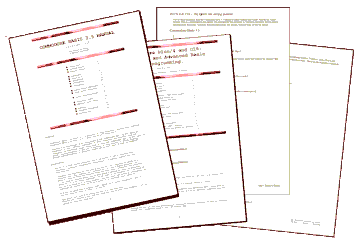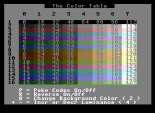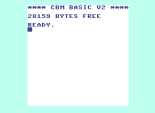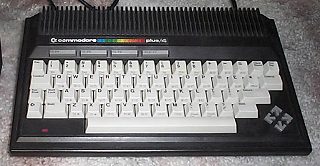They would also have normal joystick and tape ports (or adapters included with the computer). The 3-plus-1 software could have been left out and been sold separately on a cartridge to bring down the price of the computer. It could have been sold together with the computer in a bundle at a reduced price if you wanted to. This way the original 264 idea about customer selectable included software could have been doable with all the selectable software on different cartridges.
My impressions
I have just got the Plus/4, but my impression of it so far is very positive. It's little and neat. I like the basic and the graphics. The computer has very much "Commodore" feeling. I would say it's like a mix between the vic-20 (for the simplicity, one graphcis/sound chip and default colors), the C64 (for the similar graphics) and the C128 (for the powerful basic and the similarities with the 128's VDC chip features like blinking etc.) The Plus/4 also have the Esc codes that the C128 has. The machine language monitor is also almost the same. But in the same time the Plus/4 is simple and easy to survey like the vic-20. I think it's a well designed computer. The only thing I don't like about the Plus/4 is the lack of a Restore key. But there are work-arounds (Runstop+reset for example). I have written some more tips about this in the manuals below.The same people designing the Plus/4 (except for one) later designed the C128.
If you plan to get a Plus/4, then you might want to know that the 1541 diskdrive is working, the video cable is the same as for the c64 (at least composite and sound that my cable is using). But for joysticks, you need to make a little adapter, also for the tape recorder (if it isn't of the black type that has a built in adapter).
My Plus/4 is a NTSC machine with a 110V power supply. And living in Sweden I needed to buy a 220->110v converter. The Plus/4 does not need the frequency from the PSU (like the C64), so a simple converter that generates 110v 50Hz is fine. My Plus/4 has a square power plug. Others have a round one, and then I could have used an European c64 power supply instead. There are of course PAL Plus/4s as well, but I got mine for free and I like the NTSC display too. No BIG border around the screen like on all PAL Commodores. The NTSC Plus/4 has also a little faster key repeat, so it feels a little faster even though the PAL version runs faster. BUT - There is MUCH more PAL software available it seems...
Manuals
|
Janne Peršaho and I have made a set of .pdf manuals for the Plus/4, C16 and C116 computers.
The package is intended as a sufficient user's manual package (if your computer didn't come
with one)
as well as a complement to the original manuals. Download: basic35plus.zip (release 7 - released 4 May 2005) Includes four documents: If you have the original manuals, then it's probably enough to print out "advanced" and "short35". However, "basic35" does take up some things left out by the original. Advanced.pdf covers much of the things you wonder about coming from another Commodore 8 bit computer, for example how to make your own character set or if you wonder where the restore key is? Here are some complementing documents on other sites:
| 
|
My Plus/4 programs
(Most of them should work on a C16 / C116 as well.)
Boray Pics

25 nice pictures for your PAL Plus/4 in three .d64s
Parasite

parasite.zip - A little basic demo.
The Color Table

colortable.zip - The purpose
of this program is to display all available colors and to
try out different combinations. It also displays poke codes that
can be used in TED registers as well as in the Color/Attribute memory.
Emulator

emulator.zip - A toy basic emulator/simulator to simulate
the vic-20, c64, c128 and Plus/4.
Detector
detector.zip - A basic routine for detecting which computer
your program is running on - for making hardware independent basic programs. Identifies
unexpanded and expanded vic-20, c64, plus4/c16, c128 40 column mode, c128 80 column mode
and cbm-II.
Colorful
colorful.zip - A tiny basic "demo" or test...
TextWalker
A text formatting and printing program.
HTML Walker
Word processing tool / Web file viewer.
(Note that you can't use texts saved with the Plus/4's built in word processor without conversion
to petascii or ascii.)
QBench
A benchmark program to test the speed of your Commodore 8 bit computer against others.
TextPorttextport.prg - (May 2004) A program for converting petasc textfiles to ascii. Puts in all the commodore special signs, like {BLU}, {YEL}, {CLR}, {UP}, {SH-W} etc... Useful for publishing program listings. Here is an example: textport.txt (The program's own program listing). The program should work on any CBM 8bit computer with diskdrive.
Age statistics
Small statistics program.
Links
History:
at Commodore Secrets
at Commodore.ca
at Answers.com
Software,
users c64.rulez.org/pub/plus4/
& misc: Plus/4 World
cbm264.com
www.commodore16.com
Back to:
Anders Datormuseum
